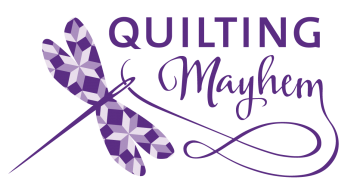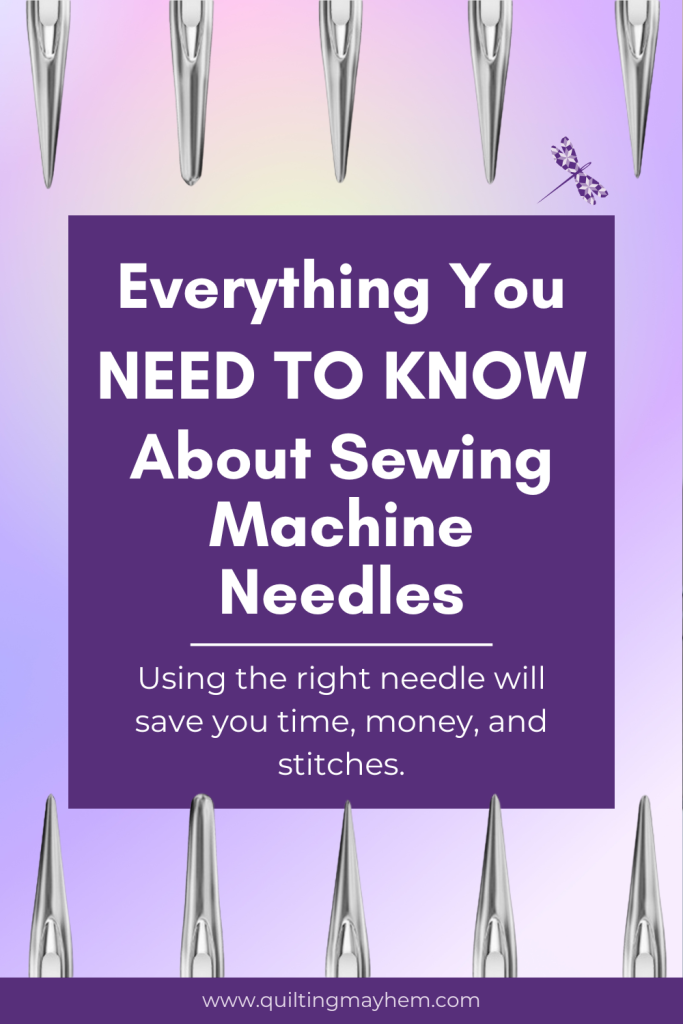All About Sewing Machine Needles
When was the last time you changed your needle? Do it now! Ok, now that there’s a fresh needle in your sewing machine, is it the right kind of needle for your project? With so many different packs of needles on the shelves at Quilting Mayhem, it can be confusing to know which one to use and when. Never fear, we’ll walk you through it so you can make the right choice for your fabric and technique.
Sewing Machine Needle Sizing
Sewing machine needles are labeled with two number, for example 80/12 or 90/14. The first number is the European size, and the second number is the American size but the important thing to remember is that the higher the number the thicker the needle. So that 80/12 needle will be thinner than the 90/14 needle.
As a general guide, lighter fabrics or fewer layers need thinner needles while heavy fabrics and thicker layers need a thicker needle.
Types of Needles
When we’re talking about types of needles, most of the time we’re talking about the different types of points and which types of projects for which the needle was designed. We’ve put together our list of the most common types of needles you should know about
Universal Needles
It’s all in the name! Universal needles are very versatile and work for a wide range of fabrics and projects. They have a slightly rounded point, which makes then perfect for woven fabrics like quilting cottons. They’re the go-to for general sewing, beginners, and if you’re working with lots of different types of fabrics. We like to keep plenty of sizes on hand for different projects but the 80/12 and the 90/14 is the most common.
Microtex Needles
Microtext needles have a very sharp, fine point, which makes them perfect for precision sewing (QuiltWorx paper piecing or Giucy Giuce mini quilts, anyone?). The sharp point pierces the fabric cleanly, reducing puckering and allowing for smooth accurate stitching. As the point is so fine, you may want to change the needle more frequently to have the best results.
Ball Point Needles
Ball point needles are designed for knit fabrics. Unlike sharp or microtex needles, which can snag or damage knit fibers, ball point needles have a rounded tip designed to slide between the fibers instead of piercing and splitting them. Use ball point needles for fabrics like jersey, interlock, or Cuddle.
Jeans Needles
Jeans needles sew through thick, dense fabric such as denim, canvas, and twill. They have a strong shaft and a sharp point that can penetrate heavy layers without breaking or bending (to a point). We use jeans needles for sewing bag projects in particular at Quilting Mayhem.
Topstitching Needles
Topstitching needles have a larger eye so that thicker threads can pass easily and a sharper point for better precision while topstitching.
You should change your needle every project or every 8 hours of sewing.
The right needle in the right size can still damage your project if it hasn’t been changed recently. A dull or damaged needle can create skipped stitches, uneven stitching tension, snag your fabric, or even damage your beautiful sewing machine. So again we say change your needle!
Here are some signs it’s time to change your needle for a new one:
- There’s a popping sound when the needle goes through fabric
- Skipped stitches or uneven stitching
- Your fabric is snagging, developing holes, or even tears when the needle passes through
- The needle has become bent or the tip looks dull
Still not sure which needle is the best one for your project? Bring it to Quilting Mayhem and let our experts help you find the best sewing machine needle for your project.



